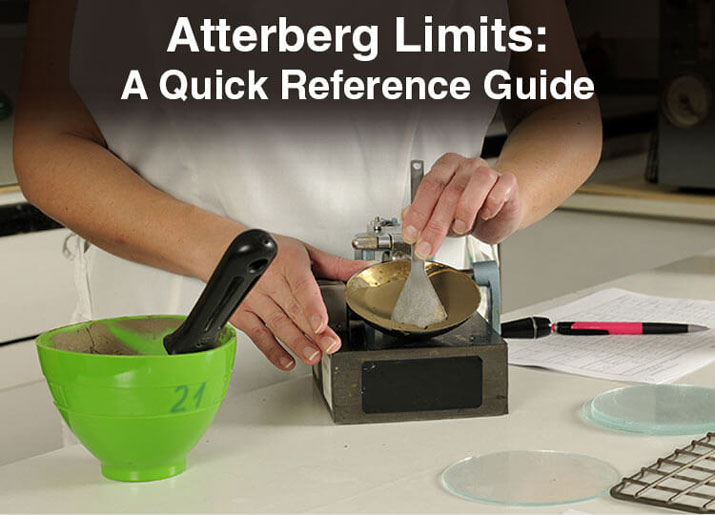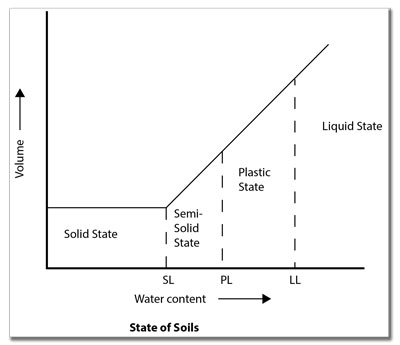
What is the Atterberg Limits Test?
Soils intended to support structures, pavements, or other loads must be evaluated by geotechnical engineers to predict their behavior under applied forces and variable moisture conditions. Soil mechanics tests in geotechnical laboratories measure particle size distribution, shear strength, moisture content, and the potential for expansion or shrinkage of cohesive soils. Atterberg limits tests establish the moisture contents at which fine-grained clay and silt soils transition between solid, semi-solid, plastic, and liquid states.
History of Atterberg Limits
In 1911, Swedish chemist and agricultural scientist Albert Atterberg was the first person to define the limits of soil consistency for the classification of fine-grained soils. He found that plasticity is a unique property of cohesive (clay and silt) soils and suggested classifying soils with a particle size of 2µm (0.002mm) or less as clays.
Karl Terzhagi and Arthur Casagrande recognized the value of characterizing soil plasticity for use in geotechnical engineering applications in the early 1930s. Casagrande refined and standardized the tests, and his methods still determine the liquid limit, plastic limit, and shrinkage limit of soils. This blog post will define the Atterberg limits, explain the test methods, and discuss the significance of the limit values and calculated indexes. We will also cover lab testing equipment used in the standard test methods.
Why are Atterberg Limits Tests Important?
As moisture contents increase, clay and silt soils go through four distinct states of consistency: solid, semi-solid, plastic, and liquid. Each stage exhibits significant differences in strength, consistency, and behavior. Atterberg limit tests accurately define the boundaries between these states using moisture contents at the points where the physical changes occur. The test values and derived indexes have direct applications in the foundation design of structures and in predicting the behavior of soil infills, embankments, and pavements. The values assess shear strength, estimate permeability, forecast settlement, and identify potentially expansive soils.

What are Liquid Limit, Plastic Limit, and Shrinkage Limit?
Now that you understand the importance of Atterberg limits let’s define the individual tests. The plastic limit, liquid limit, and shrinkage limit of soils are all test results obtained by direct measurements of the water content following the standard test methods.
- Liquid Limit (LL) is the water content at which soil changes from a plastic to a liquid state when the soil specimen is just fluid enough for a groove to close when jarred in a specified manner.
- Plastic Limit (PL) is the water content at the change from a plastic to a semi-solid state. This test involves repeatedly rolling a soil sample into a thread until it reaches a point where it crumbles.
- Shrinkage Limit (SL) is the water content where the further loss of moisture does not cause a decrease in specimen volume.
How to Calculate Atterberg Soil Indexes
Atterberg soil indexes compare the test values mathematically to express different plasticity and consistency characteristics.
Plasticity Index (PI) Calculation:
PI = LL − PL
Is the plastic limit subtracted from the liquid limit and indicates the size of the range between the two boundaries. Soils with a high PI have a higher clay content. If the PI value is higher than the low to mid-20s, the soil may be expansive under wet conditions or exhibit shrinkage in dry conditions.
Liquidity Index (LI) Formula:
LI = (Natural Water Content – PL) ÷ PI
Is determined by subtracting the Plastic limit from the natural water content of the sample, then dividing by the plasticity index. Soils with a LI of 1 or more will be closer to the liquid state. A LI of 0 or lower indicates soils that are harder and more brittle. The LI allows the prediction of soil properties at different moistures.
Consistency Index (CI) of Soil Formula:
CI = (LL − Natural Moisture Content) ÷ PI
Consistency index or relative consistency is the liquid limit of the soil, minus the natural moisture content, divided by the PI. It is related to the LI and is an indicator of the relative shear strength. As CI increases, the firmness, or shear strength of the soil also increases.
Calculating the Activity Number:
The Activity number of a soil sample is the ratio of the plasticity index to the clay-size fraction (particles finer than 2µm). Soils with an activity number over 1.25 are considered active and will have a volume change in response to moisture conditions. They will expand in wet conditions and shrink in dry conditions.
Atterberg Limits Test Procedure:
For all the Atterberg limits tests, soil samples consist of material passing a No. 40 (425µm) test sieve and are prepared for each test using wet or dry methods described in the standards. Moisture in Test specimens is adjusted by adding water, mixing with a spatula, and allowing to condition for at least 16 hours.
- Liquid Limit machines use a manually cranked cam or a small motor to lift a brass cup to a prescribed height and allow it to drop freely onto a hard rubber base. A portion of the soil sample is spread in the brass cup and divided using a grooving tool. The moisture content when the groove closes for 1/2in after 25 drops of the cup is defined as the Liquid Limit. The test methods used are ASTM D4318 and AASHTO T 89.
- Plastic Limit is determined by repeatedly remolding a small ball of moist plastic soil and manually rolling it out into a 1/8in thread. A plastic limit roller device can also be used to perform this test. The Plastic Limit is the moisture content at which the thread crumbles before being completely rolled out. Standard test methods are ASTM D4318 and AASHTO T 90.
- Shrinkage Limit is performed by molding a soil pat of moist test material into a special shrinkage dish. The dish and soil are oven-dried and weighed, then the volume of the soil specimen alone is determined by water displacement. This portion of the Atterberg test series is performed less often and is described in ASTM D4943.
Equipment needed for Atterberg Limit Test:
- Sample Preparation and Processing:
- Evaporating Dishes are used to mix specimens to the desired moisture content
- Spatula for mixing, forming, and smoothing soil specimen
- Wash Bottle to dispense mixing water
- Aluminum Containers for soil moisture samples
- Mortar and Pestle for particle size reduction
- Washing Pan for convenient clean-up of bowls and spatulas
- Liquid Limit / Plastic Limit Test Accessory Set includes items needed to run most Atterberg limits tests
- Soil Grinder is optional for efficient particle size reduction
- Digital Lab Scale or Balance with 0.01g readability
- Drying Laboratory Oven for moisture content tests
- Liquid Limit Test:
- Liquid Limit Machine, motor-driven or manually operated
- AASHTO or ASTM (Casagrande) Grooving Tool
- Plastic Limit Test:
- Glass Plate used to roll out threads of soil
- Plastic Limit Apparatus is an optional plastic limit roller apparatus for fast and consistent rolling of samples
- Shrinkage Limit Test:
- Shrinkage Limit Test Apparatus includes items needed for shrinkage limit test
- Shrinkage Dish is a unique Monel metal container as required in the test method
- Microcrystalline Wax to coat specimens, supplied in 5lb (2.3kg) quantities
- Petroleum Jelly to coat Shrinkage Dish
- Fine Thread for suspending weighing of the specimen
- Glass Plate for calibration of the dish
- Wax Melting Pot prepares wax for sample immersion
- Shrinkage Limit Test Apparatus includes items needed for shrinkage limit test
Atterberg Limits play a crucial role in the early stages of structural design to ensure that the soil performs as expected. Excessive changes in volume caused by moisture swings may cause settling or heaving of the structure.
We hope this blog post has helped you understand the role of Atterberg limits in geotechnical engineering and the equipment needed for lab tests.
Gilson Is Here to Help
Contact our testing experts for more information or to discuss your testing application.
Testing Resources
Standard Test Methods, Specifications, and Practices
Individual test methods and specifications referenced in our product descriptions, blog articles, and videos are available for review or purchase from the professional organizations noted.
- ASTM International (American Society for Testing and Materials)
- AASHTO (American Association of State Highway and Transportation Officials)
- ACI (American Concrete Institute)
- State DOTs (Departments of Transportation)
- ISO (International Organization for Standardization)
- BS (British Standards)
- EN (European Standards)


















